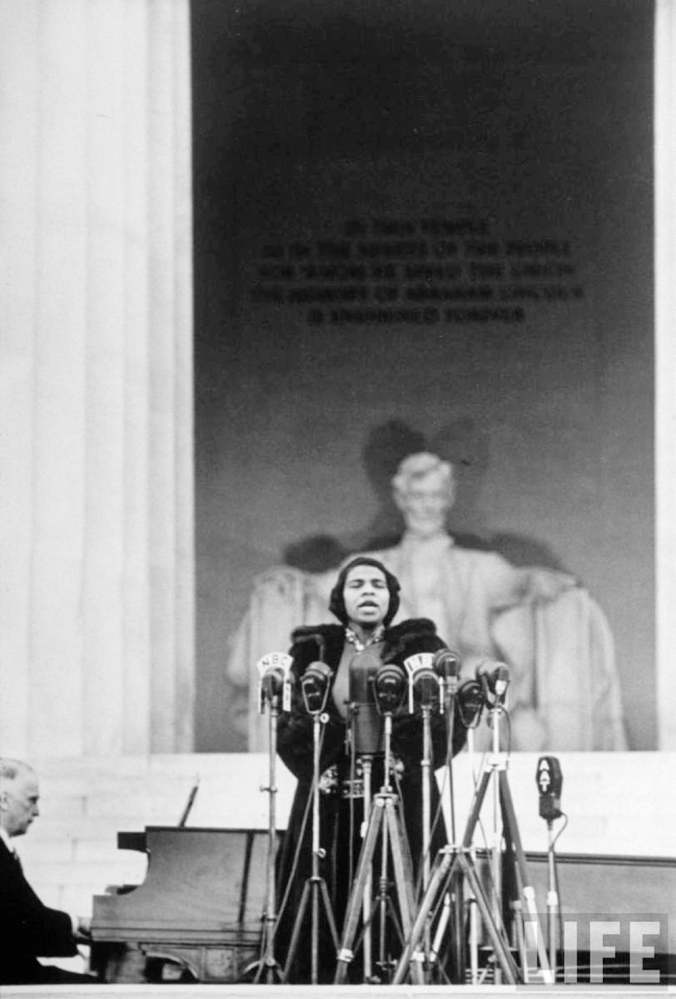It was 75 years ago that Marian Anderson gave her famous outdoor performance at the Lincoln Memorial. The concert, known today as the “Freedom Concert,” occurred on Easter Sunday, April 9, 1939.
It was a moment of great symbolic importance for racial progress in the United States.
Marian Anderson, born in Philadelphia in 1897, was a child prodigy as a vocalist. She trained at an early age with the legendary Italian voice teacher Giuseppe Boghetti. Anderson so impressed Boghetti that he allowed her to sing in the New York Philharmonic when she was still a teenager. He also took Anderson to Europe to sing, where her reputation only grew larger.
By 1936, Anderson was so well known that President Franklin Roosevelt and first lady Eleanor Roosevelt invited her to sing at the White House. Anderson was the first African-American to receive such an invitation.
It was Eleanor Roosevelt who played a major role for Anderson three years later in the Freedom Concert.
It all began when Anderson’s manager, Sol Hurok, and Howard University sought to arrange a concert for her at Constitution Hall in Washington. However, the Daughters of the American Revolution, the organization that owned the venue, refused to permit it to happen. The hall did not allow black artists to perform and also had segregated seating arrangements. Constitution Hall was Jim Crow Hall.
Eleanor Roosevelt, an ambivalent member of the Daughters of the American Revolution, denounced the organization and resigned publicly. She then worked to help arrange Anderson’s concert at the Lincoln Memorial. She wanted the event to draw attention to racism as a national issue.
The concert became a major statement against racial prejudice. Some 300 prominent individuals signed up as sponsors for the event. Actress Katherine Hepburn, unable to attend, famously sent a telegram announcing her support and sponsorship. Justices from the U.S. Supreme Court attended the performance, as did members of Congress.
Secretary of Interior Harold L. Ickes granted permission for the concert. He also introduced Anderson, saying: “In this great auditorium under the sky, all of us are free. When God gave us this wonderful outdoors and the sun, the moon and the stars, He made no distinction of race, or creed, or color.”
The concert drew an unprecedented 75,000 people, half of which were African-American. The crowd was so large it almost encircled the reflecting pool. With Eleanor Roosevelt’s intervention, NBC radio decided to broadcast the performance so millions more could hear it.
Anderson began the concert with a stirring rendition of “America.” She sang “Ave Maria,” among other numbers. And she closed with “Nobody Knows the Trouble I’ve Seen.”
In the aftermath of the concert, the symbolic importance could not be ignored. The Washington Post wrote that “a colored girl from the slums of Philadelphia” made everyone feel a “little nobler” that day.
Marian Anderson is not well known by many Americans today. But her moment of courage and dignity 75 years ago helped light a path to a better America.
Brian Gilmore is a writer for Progressive Media Project, a source of liberal commentary on domestic and international issues. This article was distributed by MCT Information Services.
Send questions/comments to the editors.



Success. Please wait for the page to reload. If the page does not reload within 5 seconds, please refresh the page.
Enter your email and password to access comments.
Hi, to comment on stories you must . This profile is in addition to your subscription and website login.
Already have a commenting profile? .
Invalid username/password.
Please check your email to confirm and complete your registration.
Only subscribers are eligible to post comments. Please subscribe or login first for digital access. Here’s why.
Use the form below to reset your password. When you've submitted your account email, we will send an email with a reset code.